One of the most interesting things to watch in the Premier League this season has been Frank Lampard’s debut season in charge of Chelsea. The former Blues midfielder and record goalscorer was tempted away from Derby County to be given the reigns at Stamford Bridge at the start of the season, and while his hands were tied due to Chelsea’s transfer ban, he has made do by promoting a number of youngsters to first-team level. Chelsea, while being flawed, have an extremely talented and exciting core of young players who have all done well in patches this season, and the future of the club looks to be in good hands if they can continue on their current trajectory. However, there seems to be a problem looming on the horizon for Lampard, one which he will have to find the solution to quite quickly if he is to truly kickstart his time in the Chelsea hot seat.
Lampard has usually favoured a three-man midfield during this season, if we consider the attacking midfielder or ‘number 10’ as a part of the midfield as well. The most-used formations by Chelsea in 2019/20 bears this out –
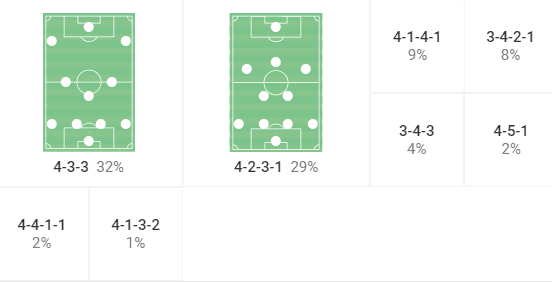
He has been helped by having some top-class midfielders at his disposal, but this situation could soon be coming to a head. With Billy Gilmour’s promotion and subsequent impression, along with Ruben Loftus-Cheek’s return from a long-term injury, Lampard will have seven players to pick from, for potentially three or even two spots. This is without even considering that Hakim Ziyech is also joining Chelsea in the summer from Ajax, and he is certainly capable of playing in a central attacking midfield slot. Thus, something has got to give, and there will probably need to be a cull of the midfield ranks before next season in order to keep the squad balanced and happy.
This piece is going to attempt to arrive at the best midfielders at Stamford Bridge, by using data analysis. Using statistics, we hope to identify the ideal midfielders for Lampard to keep and build his Chelsea squad around, and also, equally importantly, which of his options is expendable, based on his tactics so far.
First steps
Now, before we dive into the data, it is important to define the roles we are screening for, and therefore also the metrics we will use to compare these midfielders. Having looked at how Chelsea have played this season, it is safe to assume that Lampard will always play with at least one ‘shuttler’ or box-to-box midfielder, a number 8, and one deeper playmaker or a number 6. Depending on the structure of the midfield, he has then used a number 10 or a pure attacking midfielder, or even two at times, but has also eschewed one completely in favour of playing with another box-to-box midfielder. Thus, we will be screening our midfielders for these three roles. Another caveat is the fact that we have not included Billy Gilmour in this analysis as he has only played a little over 400 minutes this season, and thus the sample size is not large enough to make an informed judgement. Further, he is extremely young and bound to be a part of Chelsea’s squad going forward – the other midfielders are the ones on whom decisions need to be made. Finally, before getting into the data, one last point to note is that we have used stats from the previous season, i.e. the 2018/19 season, for Ruben Loftus-Cheek, since he has been injured for the entirety of this season. All data has been taken from Wyscout.
The different roles in Lampard’s ideal midfield
Deep-lying playmaker
We have seen Lampard use a deep-lying playmaker on most occasions this season, carrying on from his predecessor Maurizio Sarri, who had brought Italian international Jorginho with him from Napoli for this very purpose. Jorginho has since made this spot his own in Chelsea’s XI, despite some very vocal criticism from the media as well as some sections of Chelsea’s fans as well, especially during his debut season. However, it seems that his worth has finally been recognized, with there being far less clamour around his spot in the team nowadays. Nevertheless, with the wealth of options at Lampard’s disposal, it is worth seeing if his role in the team could be performed by someone else, or even be split between two players.
We will first look at these players’ ability to dictate play from deep and create chances in the final third –
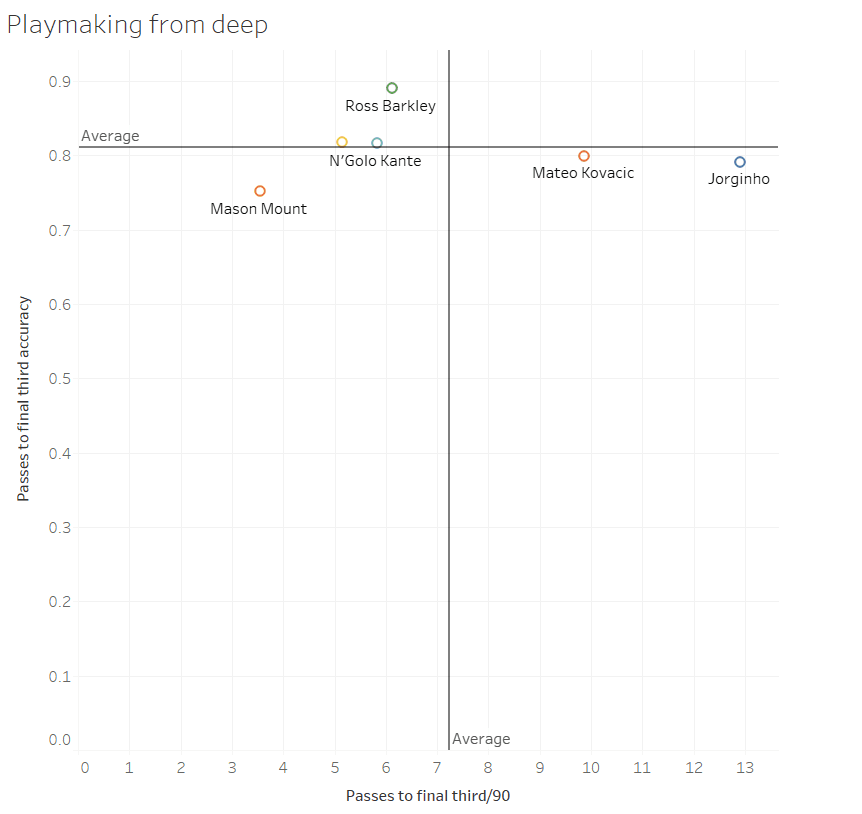
This chart shows the players’ passes to the final third per 90, and their accuracy of these passes. As can be seen, Jorginho is by far the most prolific passer into the final third from amongst these options, disproving those who believe that he does nothing more than pass sideways. While his accuracy is slightly below average, the sheer number of passes he attempts makes up for this. Mateo Kovacic is a decent replacement for him in this role, with slightly better accuracy but not as many passes per 90.
The other options are all clearly not suited to a playmaking role from a deeper position in midfield, based on this chart.
However, this is not the only check we need to do for this position. While the deepest midfielder in Lampard’s system does not have the responsibility of breaking up opposition attacks, there is still a need to be defensively competent due to the player’s position on the field.
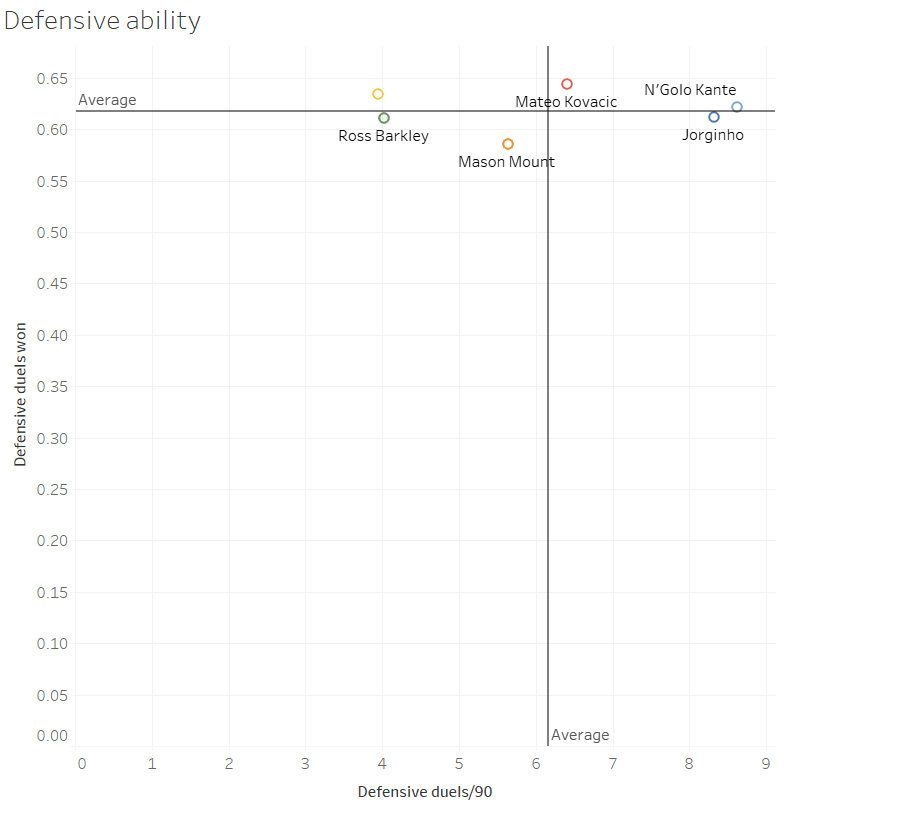
It is perhaps not surprising to see that N’Golo Kante comes out on top in this comparison, which looks at defensive duels/90 and the success rate of the same. Surprisingly though, Jorginho is not too far behind, having kept up with Kante on these measures this season. Once again, Mateo Kovacic shows the ability to be a decent understudy in this role, while Mason Mount, Ross Barkley and Ruben Loftus-Cheek are not the best from a defensive point-of-view.
Through these two checks based on the key requirements from a player in a deep midfield role, we can conclude that Jorginho is the best-suited player in the Chelsea squad for this. Mateo Kovacic can be an adequate replacement, while N’Golo Kante excels at the defensive side of things, as he has shown previously during title-winning campaigns with Leicester City and, in fact, at Chelsea.
Box-to-box midfielder
So far, the data has not thrown up too many surprises, bar maybe Jorginho’s defensive ability. Now, we need to look at the second possible role in Lampard’s midfield, that of the box-to-box midfielder. As the name suggests, the player in this role needs to be able to affect the game across the pitch, and therefore must do well in both a defensive and attacking sense. However, it differs from the deeper role in that this midfielder is tasked with moving the ball up the pitch through either progressive passes or runs, thereby breaking the opposition’s defensive lines. Kovacic has played this role for Lampard, and has proved to be a brilliant signing after Chelsea made his loan deal from Real Madrid permanent this summer. Again, though, we must look at the data to see if there are any other contenders for this spot in the side.
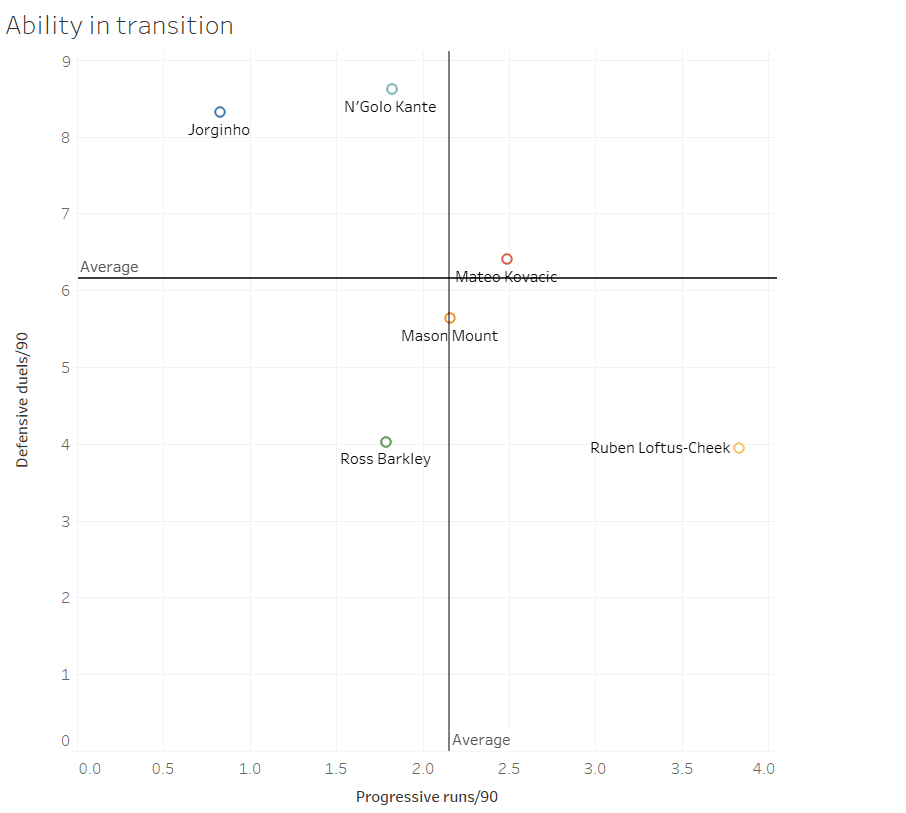
We’ve looked at progressive runs/90 and defensive duels/90, to see the player’s ability to win the ball back and quickly transition into attack. As expected, Kovacic does well on both these metrics; however, Loftus-Cheek is by far the player with the most progressive runs from amongst the Chelsea midfielders. The likes of Kante and Jorginho do win the ball back regularly but do not progress it through driving runs themselves, while Barkley and Mount do not win enough duels to be able to make this role work for themselves.
Another important attribute for us to look at is the player’s ability to win the ball back and pass forward. This does not necessarily have to be a progressive pass, but it is important that the tempo of the game is maintained and passes are made forwards wherever possible, especially under Lampard’s style of play which favours quick attacks.
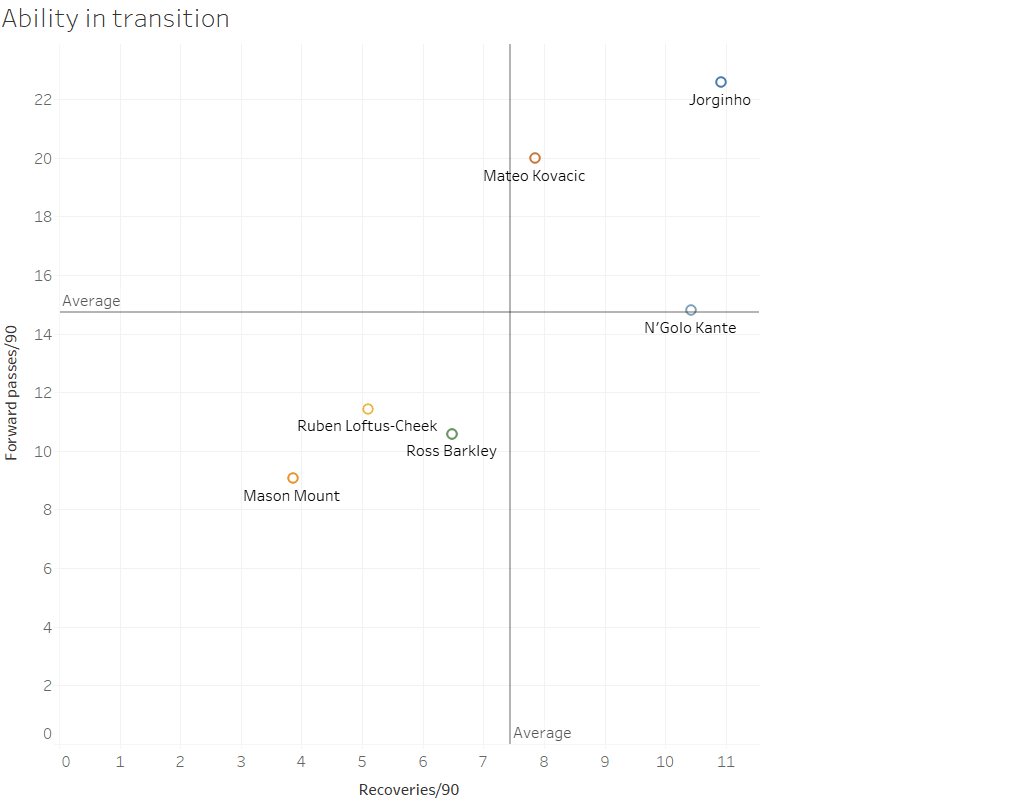
This chart looks at recoveries/90 and forward passes/90. Jorginho, Kante and Kovacic do well on these metrics, while the other three midfielders do not make enough forward passes or recoveries.
These two charts make an iron-clad case for Mateo Kovacic as the box-to-box midfielder in Lampard’s system. It was interesting to see Loftus-Cheek do well in terms of ball-carrying, though, and he only needs to improve his defensive ability to be a serious contender for Kovacic’s spot.
Attacking midfielder/number 10
This spot is perhaps the most uncertain in Chelsea’s midfield. It completely depends on Lampard’s team and tactics on the day, with there having been instances of him playing with two number 10s in certain games, while on the other hand, he has also gone without a ‘pure’ attacking midfielder on quite a few occasions. However, in the interest of balancing out this midfield selection, we shall screen for an attacking midfielder from these six available options.
Any player selected in this role needs to have an impact in the final third, so our first check will be on goals and assists. However, to arrive at a ‘true’ indicator of each player’s ability, we shall use expected goals (xG) and expected assists (xA) per 90 minutes.
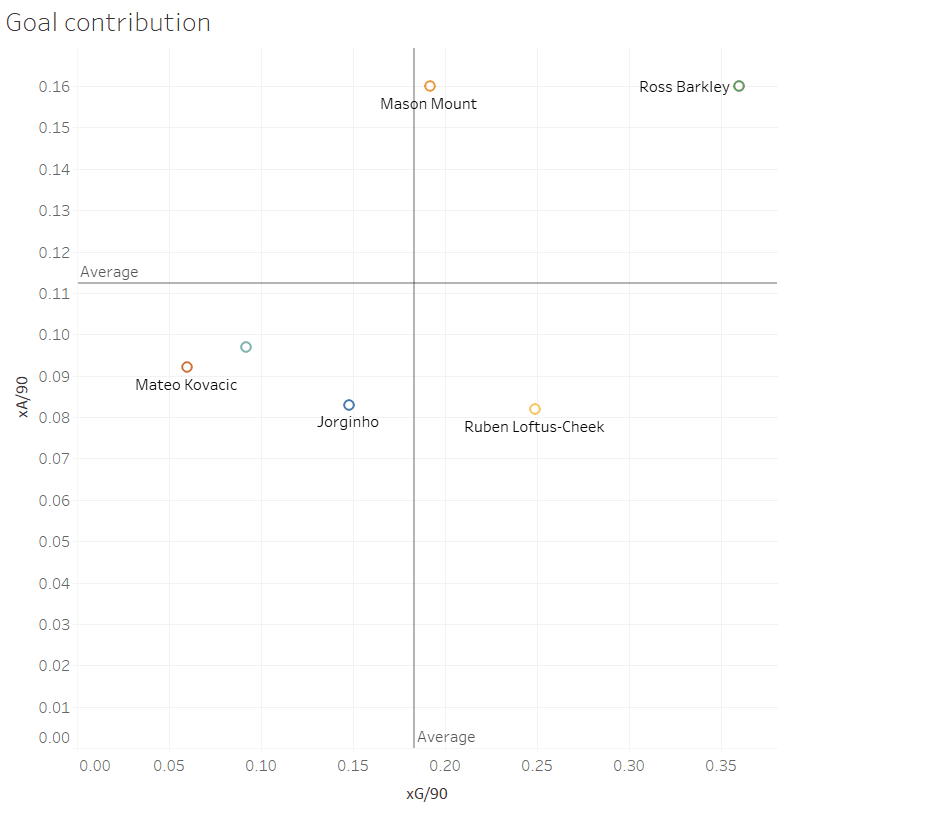
Somewhat surprisingly, it is Ross Barkley who comes out on top in this comparison. The former Everton midfielder has the highest numbers for xG/90 among our six candidates, and is more or less level with Mason Mount for xA/90. In fact, the sum of his xA per 90 and xG per 90 is a little over 0.5, meaning that he would average a goal or assist every other game based on expected numbers. Mount is a very good option as well, although he may need to improve his goal tally a little bit. Loftus-Cheek, another potential option in this role, is statistically off the pace here, needing to significantly improve his goal threat as well as his creative ability.
Another important aspect of being an attacking midfielder, is being able to penetrate through opposition defences. We shall look at a couple of charts to try and illustrate these attributes.
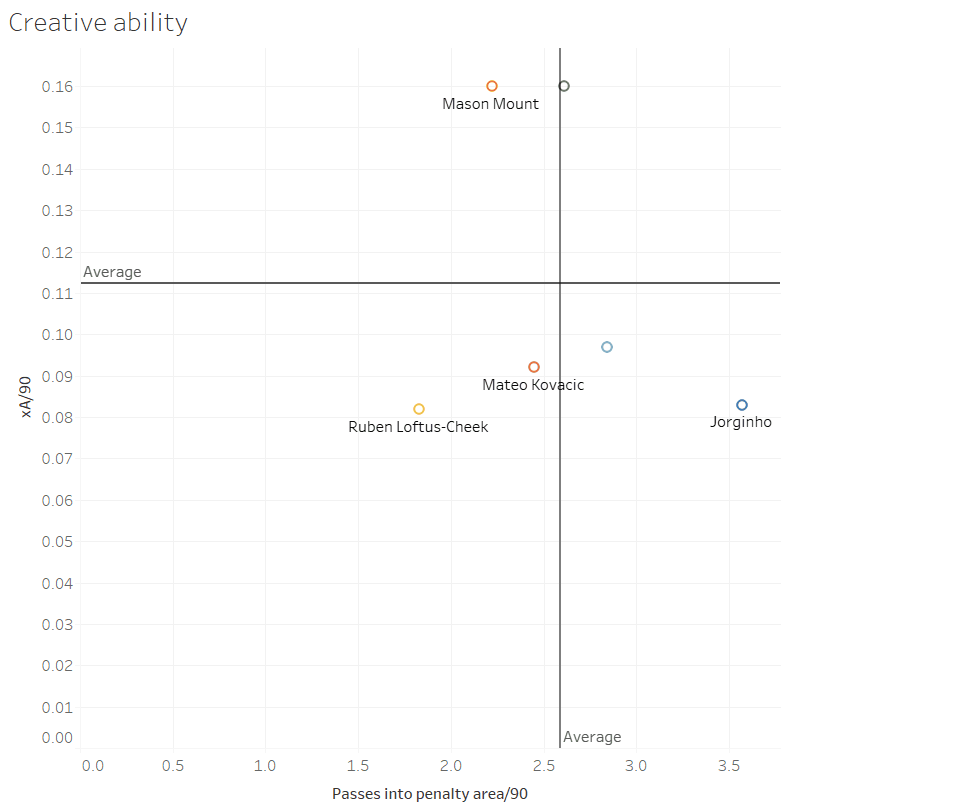
The first chart plots xA/90 and passes to the penalty area/90, to show the player’s ability to create chances for his forwards. Here too, Barkley (the green dot next to the vertical average line), does extremely well, with Mount being slightly worse off in terms of passes to the penalty area.
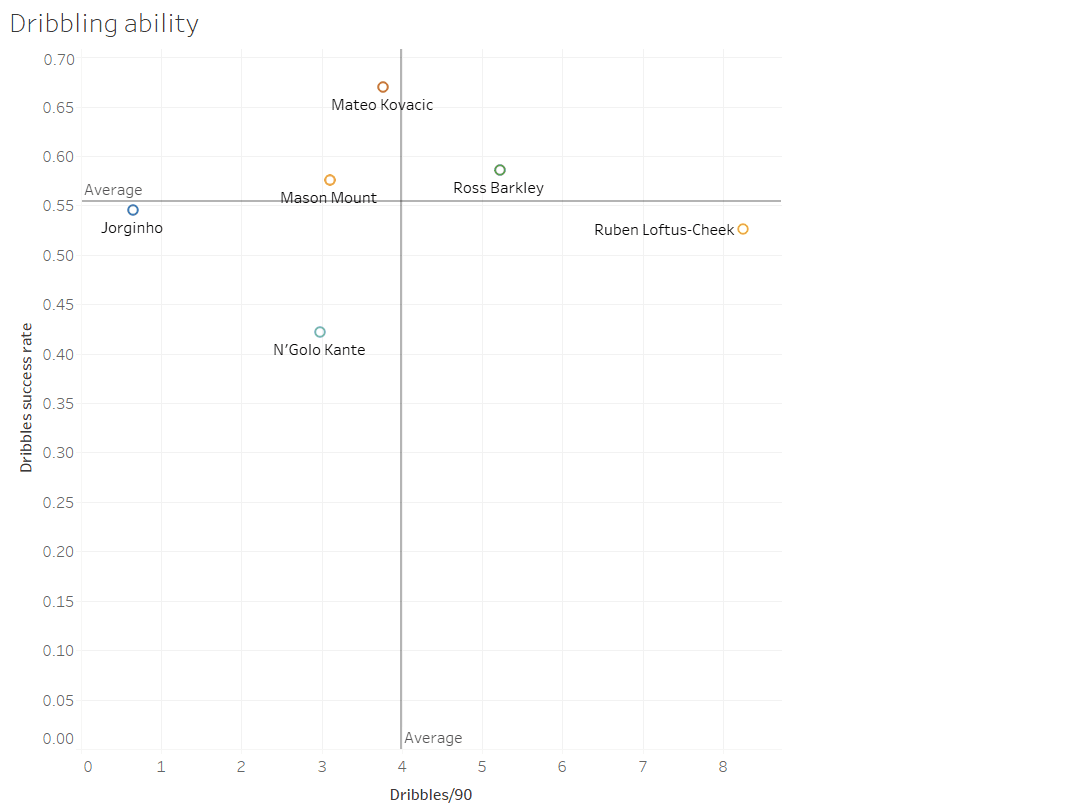
Attacking midfielders generally need to be good at dribbling, so the second chart we have here looks at the number of dribbles/90 and the dribble success rate. Barkley is once again the standout performer here, while Loftus-Cheek attempts the most dribbles of these six midfielders, but at a lower success rate than Barkley.
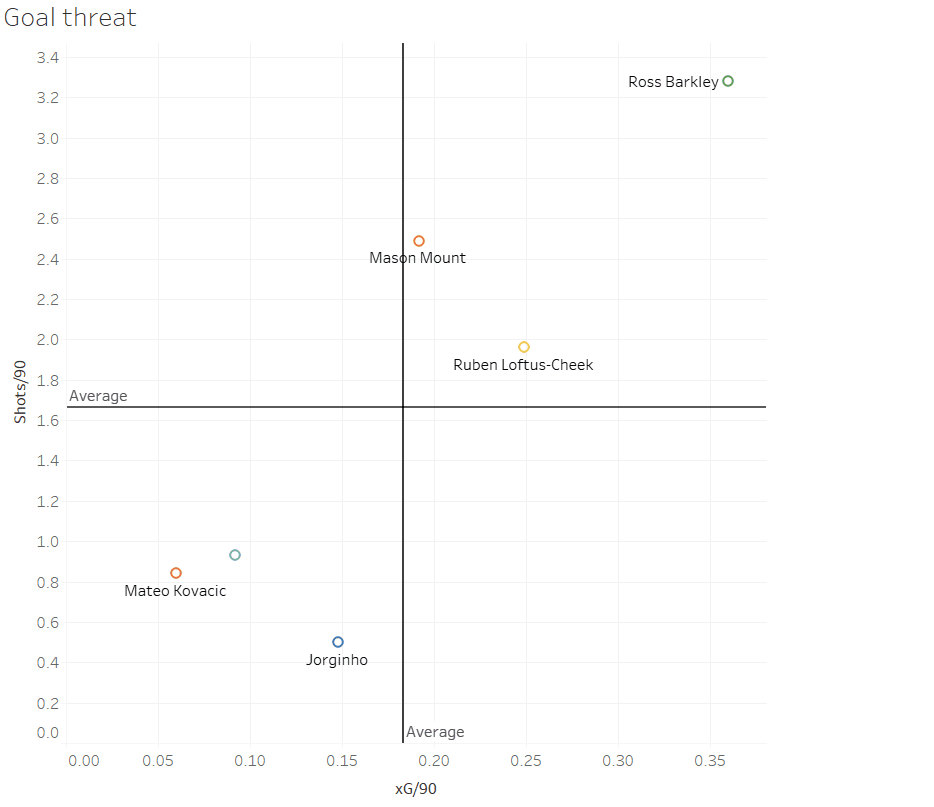
Our last check for the attacking midfield spot is for the players’ goal threat, so we look at their xG/90 and their shots/90. Once again, Barkley is the best performer, averaging more than 0.35 xG/90 from around 3.3 shots/90 this season. Loftus-Cheek and Mount all place in the upper right-hand quadrant and therefore have done better than average on both metrics, but both trail Barkley by quite some margin.
Conclusion
So, what has this purely statistical analysis of the six senior midfielders available to Frank Lampard told us? Based on the roles needed in his midfield, there have been some clear-cut winners in this analysis. Jorginho is a shoo-in for the deep-lying playmaker role, with Kovacic as the box-to-box midfielder. While these two selections would have been expected, it is in attacking midfield where we have a surprise, with Barkley winning out on almost every metric, ahead of the more popular pick in Mason Mount. While the data suggests that these three should be Chelsea’s preferred midfield trio, the data has also shown that the likes of Mount, Kante and Loftus-Cheek do have roles to play. Mount was second-best in all our attacking checks, showing that he can definitely be in the conversation for the attacking midfield spot, while Loftus-Cheek’s attributes make him an interesting option for either an attacking midfield or a box-to-box role, provided he gets better at certain key facets. N’Golo Kante is an excellent ball-winner, but not good enough at progressing the ball. He has been used as a box-to-box midfielder this season, when available, continuing from his role under Sarri last season. The stats, however, have shown that Kovacic is far better at this, and Loftus-Cheek could be an excellent player in this role as well if he develops the defensive side of this game. If Lampard does not intend to have a pure destroyer in midfield, the Frenchman could be the odd one out, and having just turned 29, this may be the best time for Chelsea to cash in on the World Cup winner, especially with Gilmour also waiting in the wings for increased involvement next season.

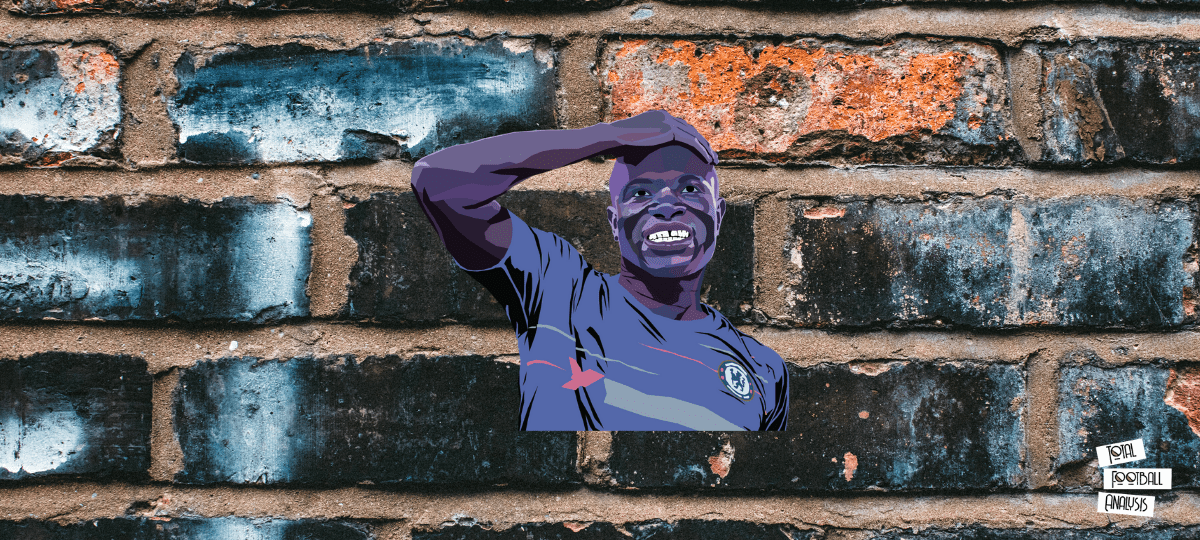



Comments